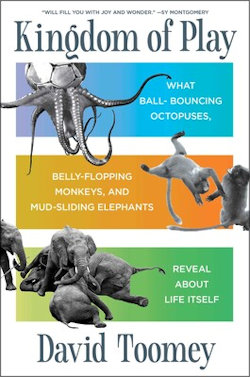SEJournal Online is the digital news magazine of the Society of Environmental Journalists. Learn more about SEJournal Online, including submission, subscription and advertising information.
 |
BookShelf: For Animals, a New Text Suggests, the Play’s the Thing
“Kingdom of Play: What Ball-Bouncing Octopuses, Belly-Flopping Monkeys, and Mud-Sliding Elephants Reveal About Life Itself”
By David Toomey
Scribner, $29
 |
Reviewed by Jennifer Weeks
Do animals play? Anyone who has watched a dog retrieve a ball or has seen a cat stalk a stuffed toy will say yes.
But think about those behaviors. Is the dog fetching the ball for fun or to please its owner? Is the cat shredding that plush-covered mouse out of enjoyment or to keep its hunting skills sharp?
“Kingdom of Play: What Ball-Bouncing Octopuses, Belly-Flopping Monkeys, and Mud-Sliding Elephants Reveal About Life Itself” is a deep dive into the science of play in animals.
Its author, David Toomey, a science writer and University of Massachusetts Amherst English professor, describes how that realm of science appeared, how it evolved and why it’s important.
Play, it turns out, is surprisingly hard to define, all the more because it’s been understudied compared to other aspects of animal behavior.
What is play, anyway?
Here are some qualities that modern researchers have proposed as characterizing animal play:
It must be “nonfunctional,” not serving a need to survive. It must be purely voluntary, not responding to some external influence. It must be unlike the animal’s other behaviors. It must involve movements that are repeated but varied. It happens when the animal is safe, healthy and well-fed, which makes it more likely that the animal is not taking the action to satisfy some basic survival needs.
One compelling hypothesis Toomey provides involves piglets running around a park, only to stop running and fall over on occasion.
That form of play can be a way of training for unexpected situations. Piglets are learning to tumble and then right themselves, as they might have to do if they are fleeing a predator, he observes.
Animals that play-fight, such as dogs, cats and wolves, often will handicap themselves by deliberately falling over, or pulling back from a fight that they are dominating.
‘When confronted with the unexpected,
an animal that plays will experience a
less pronounced physiological stress
reaction and recover more quickly.’
— David Toomey, author
‘Kingdom of Play’
“When confronted with the unexpected, an animal that plays will experience a less pronounced physiological stress reaction and recover more quickly from a collision or fall,” Toomey wrote. “It will be less likely to panic when escaping from predators and will resolve conflicts more easily and thus suffer fewer injuries from those conflicts.”
Many animals like to slide down a sloping surface, a behavior that’s been observed in dogs, mountain goats, corvids (the bird family that includes crows and ravens) and elephants. Human children like to do it, too. A slide is a kind of controlled fall that’s mildly exciting but not too threatening to be enjoyable.
Practice for sex, defusing conflict
Play serves many developmental functions.
In rats, Toomey describes how scientists have found that — at various stages — play fighting provides practice for sex; a way of reducing stress; training in social interaction with other rats; and practice in defusing conflict.
And as the animals develop, play shapes their brains by stimulating some parts, suppressing others and deepening connections between parts that are otherwise loosely connected. It “brings order to the brain and nervous system,” according to Toomey.
Toomey discusses what play looks like in many types of creatures, from birds to turtles, lizards, fish and ball-rolling bees. He connects and compares play to other processes, including dreaming, sleep and evolution, and discusses whether there may be a master gene that first made creatures able to play.
This book is a deft synthesis of evolutionary biology, neurology and the history of science. For all of the research it draws on, though, Toomey concludes that there’s something about play that’s hard to capture, except by doing it.
Think again of throwing a ball for a dog to fetch, over and over. “Tossing and retrieving, retrieving and tossing, our identities as human and canine become insignificant,” Toomey writes. “For a long moment, a moment that seems timeless and eternal, we are not human and canine in a grassy area in a city park; we are only two players in a game.”
Jennifer Weeks is senior editor for environment and cities at The Conversation U.S. and a former board member of the Society of Environmental Journalists. Her most recent review was of “Paved Paradise: How Parking Explains the World.”
* From the weekly news magazine SEJournal Online, Vol. 9, No. 30. Content from each new issue of SEJournal Online is available to the public via the SEJournal Online main page. Subscribe to the e-newsletter here. And see past issues of the SEJournal archived here.













 Advertisement
Advertisement 



